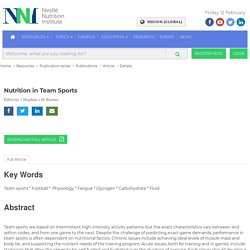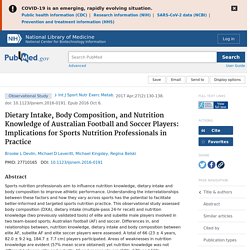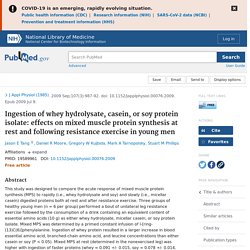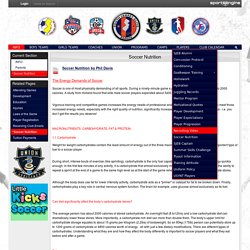

Society & Culture - Investigation. Recover Stronger: The Best Post-Game Foods For Athletes and When to Eat Them. You just played the game of your life.

After working out and training for weeks and weeks, you left it all on the field, exhausting every ounce of your energy to try and win the game. But your work doesn’t stop there. Nutrition in Team Sports. Team sports are based on intermittent high-intensity activity patterns, but the exact characteristics vary between and within codes, and from one game to the next.

Despite the challenge of predicting exact game demands, performance in team sports is often dependent on nutritional factors. Chronic issues include achieving ideal levels of muscle mass and body fat, and supporting the nutrient needs of the training program. Acute issues, both for training and in games, include strategies that allow the player to be well fuelled and hydrated over the duration of exercise. Practical nutritional recovery strategies for elite soccer players when limited time separates repeated matches. Articles were retrieved in accordance with an extensive search in several databases including MEDLINE (1966–2016); SPORTDiscus (1966–2016); PubMed (1966–2016) and Google Scholar (1980–2015).

The following search terms were used in various combinations: “recovery,” “nutrition,” “diet,” “food,” “soccer,” “football,” “supplements,” “ergogenic aids,” “glycogen re-synthesis,” “refuelling,” “repair,” “adaptation.” Only studies that were conducted using human participants were selected and references cited in the retrieved articles were also considered for inclusion. Characterising the demands of soccer match-play Soccer is a physically demanding intermittent sport which consists of recurrent high-intensity running, intensive soccer-specific actions and requirements for a high endurance capacity [11]. The game demands an ability to intersperse repeated actions at maximal or near-maximal intensity with periods of low-to-moderate intensity (including active recovery or passive rest) [12]. Food for Soccer. About Soccer Soccer (also known as football) is a team-based sport played in two 45-minute halves with a 15 minute half-time break.

A team has 11 players on the field during a game – 10 field players plus a goalkeeper. A team can also have 3 substitute players. Once a player is substituted off they cannot play again in the match. eBooks - Document - Soccer. eBooks - Document - Sports Nutrition. Dietary Intake, Body Composition, and Nutrition Knowledge of Australian Football and Soccer Players: Implications for Sports Nutrition Professionals in Practice. Sports nutrition professionals aim to influence nutrition knowledge, dietary intake and body composition to improve athletic performance.

Understanding the interrelationships between these factors and how they vary across sports has the potential to facilitate better-informed and targeted sports nutrition practice. This observational study assessed body composition (DXA), dietary intake (multiple-pass 24-hr recall) and nutrition knowledge (two previously validated tools) of elite and subelite male players involved in two team-based sports; Australian football (AF) and soccer. Differences in, and relationships between, nutrition knowledge, dietary intake and body composition between elite AF, subelite AF and elite soccer players were assessed. A total of 66 (23 ± 4 years, 82.0 ± 9.2 kg, 184.7 ± 7.7 cm) players participated. Keywords: nutrition; sports dietitian; team-based sport. Ingestion of whey hydrolysate, casein, or soy protein isolate: effects on mixed muscle protein synthesis at rest and following resistance exercise in young men.
This study was designed to compare the acute response of mixed muscle protein synthesis (MPS) to rapidly (i.e., whey hydrolysate and soy) and slowly (i.e., micellar casein) digested proteins both at rest and after resistance exercise.

Three groups of healthy young men (n = 6 per group) performed a bout of unilateral leg resistance exercise followed by the consumption of a drink containing an equivalent content of essential amino acids (10 g) as either whey hydrolysate, micellar casein, or soy protein isolate. Mixed MPS was determined by a primed constant infusion of l-[ring-(13)C(6)]phenylalanine. Ingestion of whey protein resulted in a larger increase in blood essential amino acid, branched-chain amino acid, and leucine concentrations than either casein or soy (P < 0.05). Soccer Nutrition. The Energy Demands of Soccer Soccer is one of most physically demanding of all sports.

During a ninety-minute game a player can burn as many as 1500 to 2000 calories. A study from Holland found that elite male soccer players expended about 3400 calories a day on average. Soccer Nutrition. Physiological Demands of Football. Key Points The demands on a football player during a game can be determined from match analysis and physiological measurements during match play.

A myriad of factors influences the demands of a player, such as the player’s physical capacity, technical qualities, playing position, tactical role and style of playing, as well as ball possession of the team, quality of the opponent, importance of the game, seasonal period, playing surface and environmental factors. It is mainly the high-intensity exercise periods which are important, with the amount of high-speed running having been shown to be a distinguishing factor between top-class players and those at a lower level. Australian team sports athletes prefer dietitians, the internet and nutriti...: EBSCOhost. Pitch Ahead: EBSCOhost. Nutrition and Supplementation in Soccer. Jens Bangsbo - Staff. Olivia Warnes - Dietitian and Sports Nutritionist Adelaide. Tom Taylor.